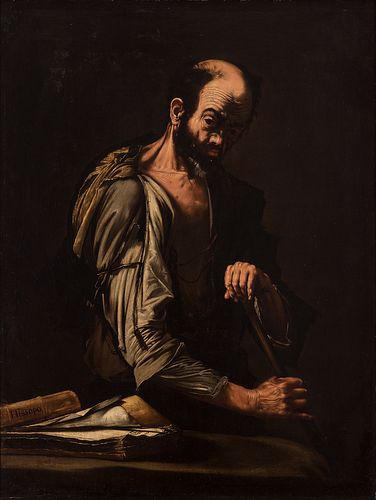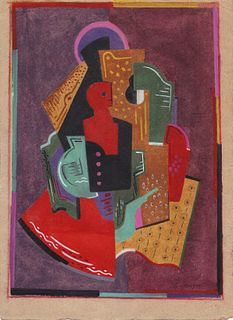Spanish school of the seventeenth century. Workshop of JOSÉ DE RIBERA (Xátiva, Valencia, 1591 - Naples, 1652). "Aesop". Oil on canvas. Relined. With a
Lot 44
About Seller
Setdart Auction House
Carrer Aragó 346
Barcelona
Spain
Setdart Subastas was born in 2004 and is currently the first online art auction in Spain with solidity, prestige and reliability guaranteed by our more than 60,000 users. Setdart has a young, dynamic and enterprising team ready to successfully manage the purchase and sale of art works through custom...Read more
Estimate:
EUR€35,000 - EUR€40,000
$37,634.41 - $43,010.75
Absentee vs Live bid
Two ways to bid:
- Leave a max absentee bid and the platform will bid on your behalf up to your maximum bid during the live auction.
- Bid live during the auction and your bids will be submitted real-time to the auctioneer.
Bid Increments
| Price | Bid Increment |
|---|---|
| EUR€0 | EUR€10 |
| EUR€200 | EUR€25 |
| EUR€500 | EUR€50 |
| EUR€1,000 | EUR€100 |
| EUR€3,000 | EUR€200 |
| EUR€5,000 | EUR€500 |
| EUR€10,000 | EUR€1,000 |
| EUR€20,000 | EUR€2,000 |
| EUR€50,000 | EUR€5,000 |
About Auction
By Setdart Auction House
Jun 1, 2021
Set Reminder
2021-06-01 09:45:00
2021-06-01 09:45:00
America/New_York
Bidsquare
Bidsquare : OLD MASTERS & SCULPTURE - Day 2
https://www.bidsquare.com/auctions/setdart-auction-house/old-masters-sculpture---day-2-6999
Setdart Auction House sofia@setdart.com
Setdart Auction House sofia@setdart.com
- Lot Description
Spanish school of the seventeenth century. Workshop of JOSÉ DE RIBERA (Xátiva, Valencia, 1591 - Naples, 1652). "Aesop". Oil on canvas. Relined. With an important setting from the seventeenth century. Attached certificate issued by Joaquín Ciervo. Provenance: Celestino Dupont collection. With a temporary export permit for Spanish Historical Heritage valid until 07/24/2022. Measures:126 x 96 cm; 153 x 121,5 cm (frame). This remarkable representation of Aesop is closely related to the canvas of the same subject attributed to José de Ribera, now housed in the Royal Monastery of San Lorenzo de El Escorial, as recorded by Pérez Sánchez and Nicola Spinosa in their book "L'Opera Completa de Ribera" (Cleveland, 1981). The success of the Españoleto and the innumerable commissions he received justified the creation of an extensive workshop to satisfy the demand of his clientele. The work of José de Ribera, a key painter belonging to the generation of the great masters of the Golden Age, was copied on numerous occasions, and it is common to find more than one version of the same canvas. The portrait that concerns us, directly linked to the artist's workshop, gives us the figure of the fabulist Aesop, a writer who lived in Greece in the late seventh century BC and early sixth century BC. The rounded expressiveness of the face, especially noticeable in his forehead full of wrinkles and his expectant gaze; the almost sculptural hands; the books and notebooks resting on the table, attentive to detail; the intensity of the coloring and the vigor of the chiaroscuro, of strong Caravaggesque influence, determine a powerful and suggestive work typical of the youthful workshop of this important painter. Ribera's first contact with naturalism took place with his arrival in Rome in 1615, where he came into contact with the Nordic caravaggists, from whom he adopted the smooth and hurried technique, the feísmo and the rigorous drawing, characteristics that shaped his style in his Roman period. However, in 1616 he went to Naples and settled there permanently. In this city Ribera became the head of the group of Neapolitan naturalists, and an important circle of painters was created around him. Despite being in Italy, Ribera sent numerous works to Spain, so his language was key to the formation of the Baroque in our country. His work brought tenebrism and, later, the full Baroque, long before it arrived directly in Spain, thus influencing the new generations of painters. On the other hand, once his Roman period was over, his painting was characterized by a very loose brushstroke, of Venetian influence, which also marked the work of his followers. Thus, Ribera's school developed a style of dramatic and contrasted illumination, clearly tenebrist, nuanced, however, by a Venetian brushstroke, impastoed and fluid. Thus, here we see a spotlight, artificial and directed, which penetrates the scene through the upper left corner and directly illuminates the fabulist, leaving the rest in semi-darkness. And we also find that totally modern brushstroke that models leaning on the light, that touch of doughy and expressive brush that the author has learned directly from the work of Ribera. José de Ribera, known as the Españoleto, was a key master of the Spanish Baroque, and in general of the history of art in Europe. Although no documentary sources or evidence of his youth are preserved, it is believed that he trained with Francisco Ribalta in Valencia, after which he went to Italy, first to the north and later to Rome, where he learned first-hand about the classicists and the tenebrism of the Dutch who settled there. Finally he settled in Naples, where he arrived in 1616. Then began his period of maturity and splendor; Ribera enjoyed fame and a large workshop, and his works spread throughout Europe through engravings. He worked for viceroys and high officials of Spanish origin settled in Naples.
- Shipping Info
-
In-house shipping available. Please inquire at admin@setdart.com.
-
- Buyer's Premium



 EUR
EUR CAD
CAD AUD
AUD GBP
GBP MXN
MXN HKD
HKD CNY
CNY MYR
MYR SEK
SEK SGD
SGD CHF
CHF THB
THB













